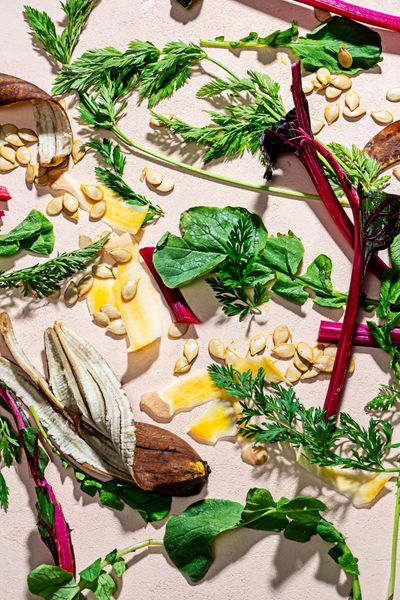Cut waste, boost flavor with skin-to-seed recipes that use entire vegetable

I pick up a butternut squash in my left hand and pull a peeler across its curves with my right, letting the ribbons drop to the cutting board. I switch to my sharp cook’s knife and hack the squash in half lengthwise, then scrape out the seeds and stringy pulp with a spoon.
After chopping the bright orange flesh, I swoop the results of my work into two piles: Cubes on the right, everything else on the left. On one side, it’s raw food destined for the oven; on the other detritus destined for the compost bin.
As I consider a drumbeat of statistics about the world’s food waste crisis, however, the line between those two piles has started to blur. These days, I look for ways to cook the entire vegetable (or fruit) from skin to seeds – and to perhaps redefine the very idea of “scraps” along the way.
The stakes are high: According to a report from the U.N. issued in March, households worldwide in 2019 discarded 11% of the food they bought, with food services wasting 5% and retail outlets 2%. That adds up to a staggering 930 million metric tons of uneaten food, enough to load up more than 23 million 40-ton trucks.
Food waste accounts for 8% to 10% of global greenhouse emissions, but perhaps most strikingly, it occurs against the stark backdrop of hunger, experienced by some 690 million people worldwide in 2019.
In a news release announcing the report’s findings, Inger Andersen, executive director of the U.N. Environment Program, put it succinctly: “Reducing food waste would cut greenhouse gas emissions, slow the destruction of nature through land conversion and pollution, enhance the availability of food and thus reduce hunger and save money at a time of global recession.”
Plenty of strategies can help you reduce food waste at home, starting with cooking more of what you already have before shopping, keeping an inventory and storing food properly to prevent spoilage. But, once you’re at your cutting board, it’s worth also looking for ways to use a higher proportion of the produce you buy – by putting peels, stems and seeds to work as valuable ingredients unto themselves.
The problem is that too many recipes for using produce scraps require you to set them aside for a future date when you’ll supposedly find the time to, say, pickle those Swiss chard stems or toast those squash seeds. And, if you can manage that, more power to you. I haven’t been so successful, aside from saving some onion and garlic skins and vegetable trimmings in my freezer for periodic brothmaking.
What I’ve started employing instead are strategies for using produce scraps in the moment in the dish I’m cooking with the rest of the ingredient.
The first step is perhaps the easiest: Peel less. Perhaps you long ago discovered that there is no reason to peel carrots and that giving them a good scrub suffices. Bring that same mentality to other root vegetables: Potatoes, sweet potatoes, turnips, rutabagas – even beets.
Why did we ever peel so many things anyhow? I blame formal (i.e. French) culinary training and its trickle-down effect on recipe developers and cookbook authors who brought a restaurant-chef standard to home cooks.
“Haute cuisine, high cuisine, high culture … is about refinement, so it’s about peeling, making things beautiful and into certain shapes,” said Amy Emberling, a co-owner at Zingerman’s Bakehouse in Ann Arbor, Mich.
“They connected the idea of something being great to it being refined. If you could afford it, you wouldn’t eat those peels.”
Max La Manna, author of “More Plants, Less Waste,” remembers when he cooked at New York City’s ABCV, owned by Jean-Georges Vongerichten. “It was a great experience, but when we would prep food, we peeled everything,” he told me.
“We would cut the carrot into a long rectangle. And we’d cut away so much of the vegetable and throw it away just to get these perfectly square sides.”
Besides avoiding food waste, there are other reasons to put the peeler aside. Not only is it a matter of efficiency, said Linda Ly, author of “The No-Waste Vegetable Cookbook,” but you can’t detect a carrot peel when it’s cooked.
And there are health implications. “The skins hold quite a bit of nutrition in a plant, so if you’re just peeling something and composting it, you’re losing it,” she said in an interview.
“Because I garden, I’m hyper aware of soil health and microbes and gut health, and there are studies saying dirt in the soil is so good for you because you’re adding to your gut biome.
“When you’re peeling, you’re getting rid of that good bacteria.”